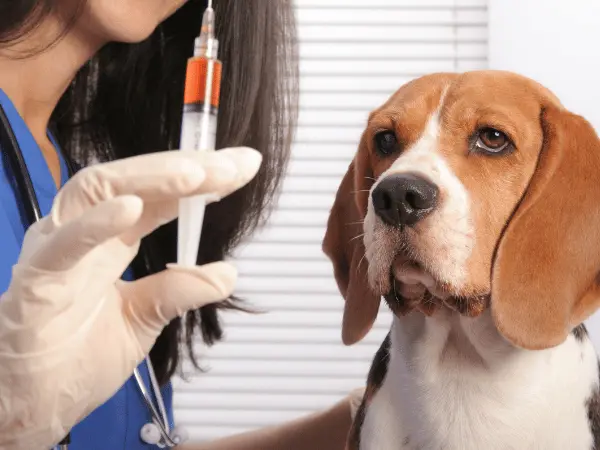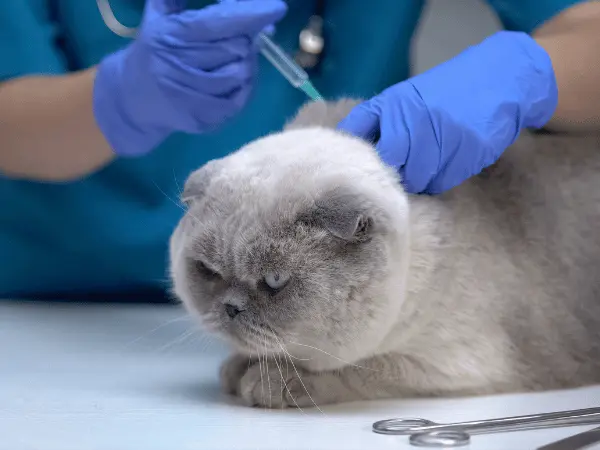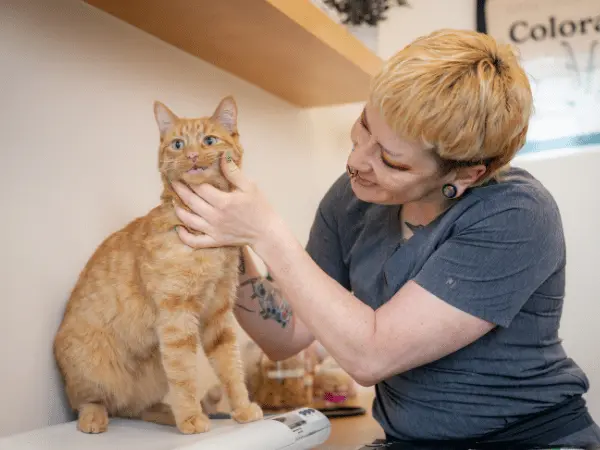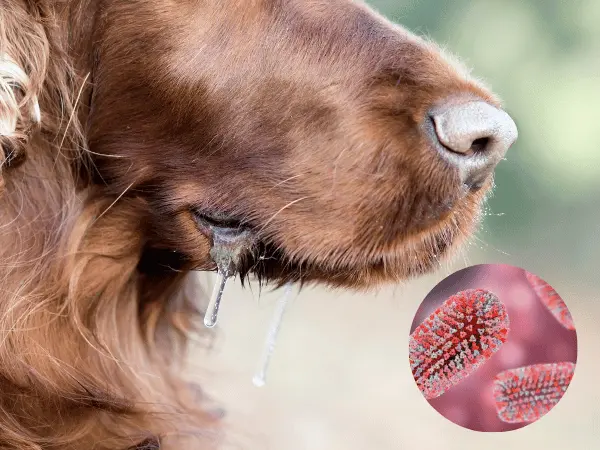Rabies is a fatal viral disease that impacts a dog’s or cat’s central nervous system. Rabies can also be transmitted to humans through a scratch, bite, or saliva of an infected animal.
Note: Around 59,000 people die from rabies each year, which further emphasizes the importance of rabies vaccinations as a preventive measure.
For all mammals, the chances of survival from rabies are slim, as this disease has a 99.9% mortality rate. It’s very important to know the signs of rabies in cats and dogs, which can have differences. Furthermore, signs can show differently for kittens and puppies compared to adult animals.
In this complete guide by Sploot on the signs of rabies in dogs and cats, we cover how rabies manifests for dogs and cats and the slight nuances regarding the signs of rabies in puppies and kittens.
What’s in This Guide?
- Overview of Rabies in Cats & Dogs
- General Signs of Rabies in Cats & Dogs
- Signs of Rabies in Cats vs. Dogs
- Signs of Rabies in Puppies & Kittens vs. Adult Pets
- Suspected Rabies in Dogs & Cats: What to Do Next
- Rabies Shots: A Compassionate & Law-Abiding Precaution

Overview of Rabies in Cats & Dogs
Rabies is a virus that affects the central nervous system; therefore, many signs of rabies in cats and dogs involve behavioral changes and nervous system functions.
Dogs and cats can be exposed to rabies in the following ways:
- A bite from an animal with rabies
- Ingesting a small animal with rabies
- Being licked by an animal with rabies (on an open wound or mucous membrane)
- Drinking breast milk from an animal with rabies
General Signs of Rabies in Cats & Dogs
Before rabies manifests any symptoms, the virus first goes through an incubation period, which can be a few days, months, or up to a year after exposure. During this time, signs of rabies in cats and dogs are absent, and the pet would appear healthy. Once symptoms appear the virus is on its way to causing deterioration and death.
There are generally two types of rabies: furious rabies and paralytic rabies. They vary based on the set of symptoms that appear; however, both sets of symptoms can appear in one case. Both types of rabies have the same lethal outcome.
Sploot veterinarian, Dr. Maggie Macpherson further explains the prevalence of each type of rabies: “Carnivores like dogs and cats mostly develop the furious type. Paralytic types are more common in prey animals like cattle.”
The following are the general rabies symptoms in cats and dogs, along with which type of rabies they are associated with:
1. Fever
- Type of rabies in dogs and cats: both furious rabies and paralytic rabies
Rabies is a viral infection. As the rabies virus makes its way into the dog’s or cat’s system, the immune system tries to fight back and can result in a fever. This is why a fever is one of the first rabies symptoms in cats and dogs to manifest—often just a few days after exposure.
2. Behavioral Changes
- Type of rabies in cats and dogs: both furious rabies and paralytic rabies
As rabies makes its way to the spinal cord and brain, behavioral changes may show, such as anxiety, restlessness, or aggression. Normally docile pets might become irritable. However, it’s also possible that normally aggressive animals (such as aloof pets and wildlife) may become unusually friendly.
3. Sensitivity to Touch, Light, and Sound
- Type of rabies in dogs and cats: furious rabies
At the stages where rabies has already reached the nervous system, sensitivity to touch, light, and sound becomes heightened, causing the infected animal to react intensely to even the slightest stimuli.
4. Lethargy & Reduced Appetite
- Type of rabies in dogs and cats: both furious rabies and paralytic rabies
Dogs and cats with rabies often experience lethargy and reduced appetite due to the virus’s impact on their nervous system, causing fatigue, fever, and discomfort. Pain and difficulty swallowing also make eating challenging, further decreasing their appetite.
5. Excessive Salivation
- Type of rabies in cats and dogs: both furious rabies and paralytic rabies
In animals infected with rabies, excessive drooling occurs because the virus affects the muscles involved in swallowing, making it difficult for them to control saliva. This symptom often leads to the classic “foaming at the mouth” appearance or drooling.
6. Paralysis
- Type of rabies in dogs and cats: paralytic rabies (end stage)
Rabies in cats and dogs can lead to progressive paralysis, which starts in the limbs and eventually spreads, causing severe muscle weakness and immobility. As paralysis advances, the animal may lose the ability to move or breathe. In cases of paralytic rabies, this can be the way an infected animal passes away.
7. Seizures
- Type of rabies in cats and dogs: furious rabies (end stage)
Seizures are a critical sign of rabies, indicating severe neurological damage as the virus disrupts normal brain function, leading to uncontrolled, violent muscle contractions. These seizures can become more frequent and intense as the disease progresses, ultimately contributing to the animal’s decline.
Signs of Rabies in Cats vs. Dogs
Is there a difference between the signs of rabies in dogs and cats? Yes, there may be some slight differences. Although the general signs of rabies are applicable to both species, the presentation can vary.
Dogs often display more overt behavioral changes. In contrast, cats may show more subtle changes, often combined with hiding. Dogs may also show distress and discomfort more openly while cats might be more secretive, making early detection in felines more challenging.
Signs of Rabies in Puppies & Kittens vs. Adult Pets
Rabies can affect puppies and kittens differently compared to adult pets. Young animals may experience a faster progression of symptoms, such as rapid onset of paralysis and severe lethargy, due to their less mature immune systems. Behavioral changes, like increased irritability or sudden friendliness, might also be less pronounced in younger pets.

Suspected Rabies in Dogs & Cats: What to Do Next
If you observe the signs of rabies in cats or dogs or suspect your pet may have been recently exposed to rabies, immediate action is critical. Here’s what you can do:
1. Ensure Your Safety
Avoid direct contact with an infected pet; rabies is a zoonotic disease and can be transmitted to humans. In addition, ensure that your dog or cat does not escape as this can endanger both people and other animals.
Note: If you have been bitten by an animal suspected to have rabies — you’d need rabies post-exposure prophylaxis (PEP). Even if there is no strong indication that the animal is rabid, it’s always better to be safe. Contact your healthcare provider as soon as possible.
2. Contact Animal Control Authorities & Your Vet
If needed, animal control authorities can assist in catching and transporting a potentially infected dog or cat. Meanwhile, your vet will conduct a thorough medical exam and guide you through the next steps for your pet. There are mainly two routes:
a. No Symptoms of Rabies (But Suspected)
If there are no clear signs of rabies in a cat or dog but there’s a possibility of exposure, quarantine measures are necessary for the pet. Typically, quarantine is…
- Around 45 days and may be done at home — if the pet is currently vaccinated
- Around 4 – 6 months, with some months in a secured facility — if the pet is unvaccinated.
Note: For dogs and cats that are overdue for a rabies booster, these situations are typically evaluated on a case-to-case basis — and titer testing may be required if there is no documentation of vaccination.
Note: If a dog or cat is suspected of having rabies and has exposed another person or pet (e.g., through a bite or saliva), a 10-day observation period is required in coordination with public health authorities. This 10-day timeframe is crucial for determining if there is a risk of rabies transmission to the exposed person or pet.
Signs of Rabies are Present
If clinical signs of rabies in cats or dogs are present — the disease is fatal, and no effective treatment exists. Euthanasia may be recommended to prevent suffering and to stop the spread of the virus to other animals and people as well.
Note: Rabies can only be definitively diagnosed post-mortem. Dr. Macpherson explains: “The virus can only be diagnosed on a sample of brain tissue and therefore we unfortunately cannot diagnose rabies without first performing euthanasia.”
3. Provide Information
If there is another potentially rabid animal at large (i.e. an infected pet, feral dog or cat, or wildlife) provide as much information as possible to animal control authorities. This will help them to catch the animal and prevent the further spread of the disease to humans and other mammals.
Rabies Shots: A Compassionate & Law-Abiding Precaution
The best way to ensure your pet’s safety is to vaccinate them for rabies as soon as possible. In addition, ensure that the vaccine is updated; rabies vaccines generally need to be updated every 1 or 3 years, depending on the most recent type of vaccine your dog or cat got.
Getting your dog or cat protected from rabies through preventative vaccinations is not just for their welfare– it also ensures your safety and that of the community. This is why in Denver, Chicago, and many other states, rabies vaccination for dogs and cats is legally required.

All-in-One Care for Dogs & Cats at Sploot Vets
Sploot Veterinary Care is your go-to vet for all-in-one care, encompassing preventative, urgent, and emergency vet services. If you need your pet vaccinated for rabies, we’re here to help!
Visit us in one of our modern vet clinics in Denver or Chicago and experience next-level care. Book an appointment online or call us at 720-770-8656 for urgent concerns.
Till next time, we’re with you every pounce of the way!
